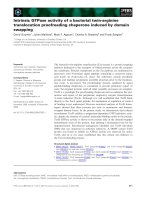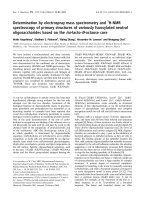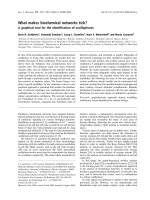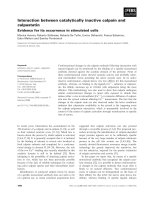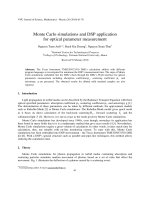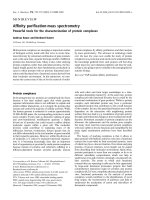Báo cáo "Monte carlo simulation by code of MCNP and experimental check for measuring thickness of materials for the specializing system of MYO-101 " ppt
Bạn đang xem bản rút gọn của tài liệu. Xem và tải ngay bản đầy đủ của tài liệu tại đây (146.91 KB, 7 trang )
VNU Journal of Science, Mathematics - Physics 26 (2010) 43-49
43
Monte carlo simulation by code of MCNP and experimental
check for measuring thickness of materials for the specializing
system of MYO-101
Bui Van Loat
1,
*, Nguyen Van Hung
2
, Hoang Sy Minh Phuong
2
1
Hanoi Umiversity of Science, 334 Nguyen Trai, Thanh Xuan Hanoi
2
Nuclear Research Institute, N
0
1 Nguyen Tu Luc, Dalat
Received 15 December 2009
Abstract. At present, thickness measurement of materials based on effect of backscattering
gamma-ray has been widely used in industry in our country. The report presented research in
measuring thickness of some materials such as paper, plastic, aluminum and steel with using the
dedicated system of MYO-101, having scintillation detector of YAP(Ce) and gamma-ray of 60
keV of Am-241 source, by Monte-Carlo simulation using the code of MCNP. The simulation was
checked by experimental measurements. The results were shown that they were in accordance with
the range of error. This research has been useful for training activities with a view of human
resources development in the field of application of nuclear technique in industry in Vietnam.
Keywords: Monte-Carlo simulation, Monte Carlo N-Particle, Backscattering gamma, Scintillation
detector, Nuclear technique.
1. Introduction
At present, gamma backscattering method is applied in industry to measure the thickness of light
materials, such as in the paper with the use of dedicated measuring systems using beta or low–energy
gamma radioactive sources. The advantage of this method is to measure the thickness from only one
side of the material. Radioactive source and detector are from the same side, and it is favorable in
industrial conveyor systems; preferably with light materials, but the low efficiency [1]. Therefore, in
order to support and compare them with experimental results, research method of Monte Carlo
simulation by code of MCNP (Monte Carlo N-Particles) for thickness measurement based on the
effect of backscattering gamma-ray is applied in this report [2,3].
Experimental equipment is the dedicated system of MYO-101 for measuring material thickness
based on backscattering effect of gamma-ray, that was supported by NuTEC/JAEA, Japan in 2007.
This system having sealed source of Am-241 (with activity of 370 MBq and gamma energy of 60
keV) was fixed in the dedicated scintillation detector of Yap(Ce) [Yttrium Aluminum Perovskite
activated with Cerium] has been used for the experimental measurements in some of training courses
on "Application of Nuclear Technique in Industry and Environment” in cooperation with
NuTEC/JAEA, that have been held at the Nuclear Research Institute. The content of this report
______
*
Corresponding author. E-mail:
B.V. Loat et al. / VNU Journal of Science, Mathematics - Physics 26 (2010) 43-49
44
includes two parts: i) the theoretical simulation of measuring intensity for thickness of materials by
the system of MYO-101 with using code of MCNP; ii) experimental measure on the thicknesses of
light materials (such as paper, plastic, aluminum and thin stainless steel), and the results between the
data of theoretical simulation and those of experimental measurements are compared together [3-5].
For backscattering effect, intensity of gamma-ray backscattered from the light material is given as
a function of thickness of x as follows:
I(x) = I
0
+ I
s
[1 - exp(-µρx)] (1)
Where I
0
is
an intensity of background radiation (without material);
I
s
is a coefficient; I
s
(1 - exp [(- (µ/ρ) x]) is an intensity of scattered radiation; µ is a mass attenuation
coefficient; ρ is a density of material (g/cm
3
); and x is a mass thickness of material (g/cm
2
) [3].
2. Experimental
Simulation experiments using the cylinder source of Am-241 (with geometrial sizes and those
simulated by MCNP are illustrated in Figure 1 and 2, respectively) to be placed in the scintillation
detector of Yap(Ce) of the dedicated system of MYO-101 are carried out for measuring thickness of
light materials (such as white paper, yellow paper, plastic, aluminum and thin stainless steel) based on
the effect of backscattering gamma-ray.
Sheets of standard material with different thicknesses (size of 10x10 cm
2
/sheet) are placed
diametrically opposite with the center of Am-241 source (close to front face of source). Then measure
count rate when placing additional standard sheets of the same material. Thickness of the material is
gradually increased until obtained count rate reaches a saturation value [3].
Fig. 1. Cross-section view of Am-241 source.
Fig. 2. 3D display map for Am-241 source simulated
by MCNP (XZ).
The system of MYO-101 consists of blocks as follows: a detector with well scintillation crystal of
Yap(Ce) having outer diameter of 60 mm, inner diameter of 15 mm, thickness of 1 mm, and
aluminum incident window with thickness of 0.3 mm, and a photomultiplier working at high voltage
of 1300 V; Am-241 source with activity of 370 MBq (10 mCi) in a disk shape (having overall
diameter of 8 mm, overall thickness of 5 mm, active diameter of 4.2 mm, beryllium window with
thickness of 1 mm) is placed in well of the crystal. The drawing of the detector is shown in Figure 3
and its simulation using MCNP (having adding block of Pb shielded near, front of the crystal) is
shown in Figure 4 [2].
B.V. Loat et al. / VNU Journal of Science, Mathematics - Physics 26 (2010) 43-49
45
Fig. 3. Drawing of the detector.
Results of experimentally measured intensity I(cps) of scattering gamma-ray for different material
are listed in Table 1. With model to be system of MYO-101, the program is runned with 50 million
particles in order to obtain calculation data from MCNP. The calculation results from MCNP and
experimentally measured ones are compared together [4]. From the data, graphs and fitted equations
for different material could be built.
Table 1. Intensity of scattering gamma-ray for different material
White paper Yellow paper Plastic Aluminum Thin stainles steel
Thickness
(cm))
Intensity
(cps)
Thickness
(cm))
Intensity
(cps)
Thickness
(cm))
Intensity
(cps)
Thickness
(cm))
Intensity
(cps)
Thickness
(cm))
Intensity
(cps)
0,00000 4148
0,00000 4148 0,00000 4148 0,00000 4148 0,00000 4148
0,01892 9562
0,01783 11585 0,14400 36146 0,13500 28305 0,07525 11462
0,04730 14236
0,03566 12715 0,28800 74350 0,27000 58491 0,15049 13958
0,09460 17546
0,08916 23447 0,43200 108025 0,40500 87406 0,22574 15351
0,18920 26949
0,17832 58111 0,57600 145655 0,54000 130753 0,30098 18519
0,28380 44433
0,26748 87313 0,72000 182938 0,67500 159905 0,37623 20983
0,37840 64088
0,35664 123031 0,86400 210076 1,35000 265989 0,75246 23507
0,61490 136523
0,44580 143624 1,00800 235077 1,48500 296762 0,82770 25272
0,89870 241336
0,53496 156071 1,15200 259568 1,62000 318022 0,90295 26387
1,04060 288142
0,62412 186952 1,29600 284713 1,75500 345582 0,97819 27530
1,13520 324791
0,71328 235219 1,44000 301782 1,89000 363337 1,05344 27561
1,41900 389961
0,80244 267896 1,58400 318880 2,02500 377415 1,12869 27288
1,51360 408444
0,89160 303467 1,72800 330860 2,70000 442502 1,50491 27339
1,60820 419666
0,98076 338028 1,87200 339014 2,83500 451070 1,58016 27170
1,70280 439361
1,06992 371921 2,01600 350013 2,97000 461154 1,65541 27412
1,89200 463949
1,15908 400024 2,16000 356679 3,10500 472244 1,73065 27608
1,98660 475032
1,24824 429553 3,24000 485455 1,80590 27452
2,08120 486167
1,33740 459869 3,37500 494754 1,88114 27547
2,17580 491244
1,42656 472848 4,05000 518898 2,25737 27400
Tungsten container (Collimator)
Collimator
Housing
Photomultiplier
Fitting for probe
B.V. Loat et al. / VNU Journal of Science, Mathematics - Physics 26 (2010) 43-49
46
2,27040 503952
1,51572 509158 4,18500 522152
2,36500 516179
1,60488 533999 4,32000 525706
2,45960 523625
1,69404 553640 4,45500 528051
2,55420 531286
1,78320 574533 4,59000 530954
2,64880 537556
1,96152 605563 4,72500 533328
2,74340 545102
2,13984 635462 5,40000 537593
2,83800 552917
2,31816 660465 5,53500 540718
2,93260 557884
2,49648 684751 5,67000 541790
3,02720 564076
2,67480 698921 5,80500 544384
3,12180 567563
2,85312 716016 5,94000 545849
3,21640 572741
3,03144 722884 6,07500 548231
3,31100 575864
3,20976 754801 6,75000 551659
3,40560 580593
3,38808 762326 6,88500 552283
3,59480 590764
3,56640 775050 7,02000 552077
3,68940 593266
3,74472 789016 7,15500 553123
3,78400 596906
3,92304 802255 7,29000 552492
3,87860 598615
4,10136 806165 7,42500 555629
3,97320 603899
4,27968 814162
4,16240 609744
4,45800 814683
4,25700 611430
4,63632 815940
4,35160 613616
4,81464 817148
4,44620 616402
4,99296 822473
4,54080 617854
5,17128 832300
4,63540 618425
5,34960 834359
4,73000 621276
5,52792 835196
4,82460 624694
5,70624 838234
4,91920 627512
5,88456 839046
5,01380 627013
Table 2. Comparing features of materials to be measured through the experiments using the system of MYO-101
and calculated by MCNP simulation
Experimental MCNP
Material
Fitted equation
Saturated
thickness
(cm)
Fitted equation
Saturated
thickness
(cm)
Deviation
(%)
White
paper
0,5852
4148695491,4500(1)
x
Ie
−
=+−
6,90
0,4019
3330668266,6900(1)
x
Ie
−
=+−
7,97 13,44
Yellow
paper
0,5060
4148905544,3500(1)
x
Ie
−
=+−
6,87
0,44478
3330668266,6900(1)
x
Ie
−
=+−
7,88 12,87
Plastic
0,62533
4148489372,9270(1)
x
Ie
−
=+−
5,61
0,57446
3330668266,6900(1)
x
Ie
−
=+−
6,10 8,14
Alumi-
num
0,51549
4148572493,6760(1)
x
Ie
−
=+−
6,80
0,49389
3330668266,6900(1)
x
Ie
−
=+−
7,10 4,19
Thin
stainles
steel
3,28106
414823348,31840(1)
x
Ie
−
=+−
1,07
3,17505
3330668266,6900(1)
x
Ie
−
=+−
1,10 3,23
B.V. Loat et al. / VNU Journal of Science, Mathematics - Physics 26 (2010) 43-49
47
Proccessing of the measured results and drawing of graphs are done by software of Origin. The
fitted equations and saturation thicknesses of 97% for each material are listed in Table 2, where I is
pulse count rate (cps) and x is mass thickness (g/cm
2
).
Graphs that describe dependence between counting rate and mass thickness are shown in Figure 5,
6, 7, 8 and 9 for white paper, yellow paper, plastic, aluminum and steel, respectively.
Fig. 4. Vertical drawing of the detector simuated by
MCNP (XZ).
Fig. 5. Comparison of count rate versus thickness
between simulation by MCNP and experimental
measurement for white paper.
Fig. 6. Comparison of count rate versus thickness
between simulation by MCNP and experimental
measurement for yellow paper.
Fig. 7. Comparison of count rate versus thickness
between simulation by MCNP and experimental
measurement for plastic.
Fig. 8. Comparison of count rate versus thickness
between simulation by MCNP and experimental
measurement for aluminum.
Fig. 9. Comparison of count rate versus thickness
between simulation by MCNP and experimental
measurement for thin stainless steel.
B.V. Loat et al. / VNU Journal of Science, Mathematics - Physics 26 (2010) 43-49
48
From comparison of the measuring experimentally data and the calculated ones by MCNP, it could
be found out conversion coefficients (ratios) for mass absolution coefficient of µ from the experiments
to MCNP for the system of MYO-101 are indicated in Table 3 [6].
Table 3. Conversion coefficients for mass absolution coefficient from the experimental data to simulation ones
by MCNP for the system of MYO-101
No. Material
Experimental
(cm
2
/g)
MCNP(cm
2
/g) Conversion coefficient
1 White paper 0,51 0,44 1,16
2 Yellow paper 0,51 0,44 1,16
3 Plastic 0,62 0,57 1,09
4 Aluminum 0,52 0,49 1,06
5 Thin stainless steel 3,28 3,18 1,03
Average 1,10
From the comparison between simulation results and experimental ones, it is shown when
increasing thicknesses of the same material, intensity of scattering gamma-ray will increase also.
However, its intensity is increased up only to a certain level (namely saturated intensity), and is not
increased further when increasing continuously the thicknesses. In the case of using source of Am-
241, the light materials to be used commonly for measuring their thicknesses (based on the scattering
effect) are sheets of white paper, yellow paper, plastic, aluminum and steel. When increasing
thicknesses of the same material to the threshold value determined as in Table 1, the count rate will
not be increased further, namely as the saturated thicknesse for each material (heavier material will
give smaller saturated thickness) with energy and scattering angle according to the geometrical layout
of the system of MYO-101. This is explained as follows: When increasing thickness of the material,
gamma-rays will have an opportunity to cause more scattering, but in which competition between
absorption process and scattering one in the material is increased. When increasing thickness of the
materials to the critical value, the processes of scattering and absorption will be compensated. Thus, an
amount of gamma-rays scattered from the material in order to crystal of the detector are not changed
and it will create a saturated region [1,5,7].
From Table 2, it is shown that relative diviation between simulation results and measured
experimentally ones are in the range of 3.3 - 15.5%. The diviation are gradually increased from steel
(3.3%) to white paper (15.5%). This is understandable, in the case of very light materials such as the
light paper, we have to use many sheets of the papers in order to increase their thickness, but missing
thin layers of air between two adjacent panels in using MCNP. Therefore, there will be more diviation
for very light materials such as paper in comparison with heavier materials such as stainless steel or
aluminum.
3. Conclusion
Through comparison of the results calculated by MCNP and measured experimentally, it could be
seen the advantage of MCNP program for simulating backscattering effect of gamma-ray in the case
of the dedicated system of MYO-101 with using scintillation detector of Yap(Ce). From the initial
results performed for several materials such as white paper, yellow paper, plastic, aluminum and thin
stainless steel, conversion coefficients from MCNP to experiments were determined. These results will
B.V. Loat et al. / VNU Journal of Science, Mathematics - Physics 26 (2010) 43-49
49
help for study in other materials by the simulation to predict linear absorption coefficient and saturated
thickness before conducting experiments. In addition, the results of this research have also been very
useful in training staffs and students in the field of application of nuclear technique in industry.
Acknowledgments. This work is financially supported by QG-09-06 Project of VNU.
References
[1] IAEA-TECDOC-1459, Technical data on nucleonic gauges, IAEA (2005).
[2] Kunihiro Ishii, Gamma-ray Gauge: Model MYO-101, Ohyo Keken Kogyo Co.Ltd, Japan (2006).
[3] Hiroshi Tominaga, Experimental practice for nucleonic thickness gauge, NuTEC/JAEA, Japan (2007).
[4] Glen F. Knoll, Radiation Detection and Measurement, Third edition, John Wiley & Sons (1999).
[5] Syed Naeem Ahmed, Physics and Engineering of Radiation Detection, First edition, Academic Press Inc, Published by
Elsevier (2007).
[6] I.F. Briesmeister, Ed., MCNP4C2 - Monte Carlo N-Particle Transport Code System, CCC-701 (2001).
[7] Gordon R.Gilmore, Practical Gamma-ray Spectrometry, Second Edition, Nuclear Training Services Ltd Warrington,
UK, John Wiley & Sons Ltd (2008).
